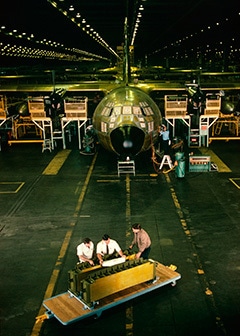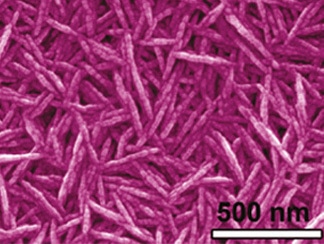Today, nanotechnology finds a number of uses within the aerospace industry. The industry’s primary development goals match almost exactly with the advantages of nanomaterials, which have begun to replace traditional bulk metals such as steel.
 |
|
Figure 1. The aerospace industry is under pressure to improve its environmental footprint, primarily by making aircraft more efficient. Image Credits: Bureau of Labor Statistics.
|
The aerospace industry is one of the most important heavy industries in the world. Many companies rely on their ability to transport both products and people around the world at speed. Therefore, it is unsurprising that the global aircraft manufacturing market was valued at approximately 400 billion USD in 2017, with a predominant portion of this accounted for by military spending.
However, along with substantial economic value comes huge resource consumption, and one of the largest carbon footprints on the planet relative to the size of the market. For this reason, the primary drivers in current aerospace R&D are towards lighter structural materials and more efficient engines - the uniting goal being to curb fuel consumption and carbon emissions associated with air travel and freight. The potential nanomaterials and nanoengineering have in helping to achieve these goals, justifies the significant interest in nanotechnology expressed by the aerospace industry.
Nanostructured Metals
Nanostructured metals, defined as metals consisting of nano-scale crystallites, exhibit considerably improved properties compared to their counterparts with microscale or larger grain structure. This is particularly noticeable for properties crucial to aerospace applications - primarily yield strength, tensile strength, corrosion resistance, and a low density to facilitate substantial reductions in structural weight.
Furthermore, it has been demonstrated that nanostructured metals not only display enhanced properties but can also be engineered to exhibit properties uncharacteristic of conventionally-sized materials. An example of this is a nanostructured titanium-nickel alloy, which, in combination with extraordinary yield strength, exhibits superelasticity.

Figure 2. Bulk nanostructured metals exhibit much better mechanical properties and corrosion resistance than their counterparts with larger crystal structures. Image Credits: Los Alamos National Laboratory.
Polymer Nanocomposites
Various nanomaterials have been used with success in aircraft construction as filler materials, to enhance the properties of structural and non-structural polymers. The most commonly used nanocomposites include carbon nanotubes, nanoclays, nanofibres, and graphene.
Carbon nanotubes (CNTs) have gained traction for their use as fillers in various polymers due to their exceptional stiffness, toughness, and unique electrical properties. Memorably, CNTs electrical properties were utilized for the advanced electrostatic charge dissipation and electromagnetic interference shielding of the Jupiter satellite launched in 2011.
Nanoclays are also used frequently in aerospace manufacturing due to their flame retardant properties. This, combined with their high-strength, low weight, and relatively low cost, means epoxy/clay nanocomposites have provided an affordable, high-performance substitute to titanium oxide for the use as aviation fuel tanks.
An exceptional advantage offered by all polymer nano-fillers is their inherent defect-free structure at a crystal level. As a result, their resistance to deformation is far superior to that of larger polymers. Considering the extreme load aerospace vehicles are subjected to, this has the potential to reduce the time and cost incurred for required maintenance.
Tribological and Anti-Corrosion Coatings
Another trend in the field of aircraft materials is the adoption of nanocoatings, such as magnesium alloys, to increase the durability of metals. On the one hand, magnesium alloys are far lighter than steel or aluminum; however, they are compromised by their susceptibility to corrosion, caused by the high chemical reactivity of magnesium.
The most widely implemented solution to combat corrosion is to use a surface coating. However, the chromium-based coatings favored by manufacturers are well-documented to be carcinogenic.
Nanomaterials used as an alternative to chrome, anti-corrosion coatings include silicon and boron oxides and cobalt-phosphorous nanocrystals. However, a suitable coating for aluminum, widely used in aircraft structures due to its equal performance to chromium, is yet to be developed and poses one of the most pressing challenges for the sector. The heterogeneous surface of aluminum renders it particularly vulnerable to corrosion, the rate of which is further exasperated by the inclusion of alloying elements and precipitates. Current research has identified magnesium nanocomposites as a promising alternative, although this investigation is very much in its infancy and therefore further extensive analysis is required.
As well as being used to prevent chemical corrosion, nanocoatings are also applied to mechanical components that are subjected to high temperatures and friction wear, such as turbine blades. These tribological coatings can drastically lower the friction coefficient and improve resistance to wear - significantly improving engine efficiency and consequentially helping to curb fuel consumption.
Many nanostructured and nanoscale coating materials have been suggested as possible friction modifying agents, including carbides, nitrides, metals, and various ceramics.

Figure 3. The defense sector drives innovation in many industries, and aerospace is no exception. High-performance military aircraft require exceptional materials, which will eventually find their way into commercial vehicles. Image Credits: Penn State University.
Conclusion
The drive for lighter and more efficient aircraft has led to the rapid adoption of nanotechnology in aerospace manufacturing. To remain concise, this article presents an overview of just some of the identified advantages and applications of the nanomaterials used.
The main roadblock for widespread adoption of nanomaterials is the uncertainty over their environmental and health implications. While nanomaterials can often be less toxic than the current materials used, the replacement of chromium coatings being a key example, the effects of long-term exposure to these novel materials are yet to be established.
Nevertheless, the potential of nanotechnology in the aerospace industry cannot be denied. Nanotechnology is a crucial tool that can be used to engineer vehicles with the necessary properties to endure the harsh conditions of space. It is evident why nanotechnology forms one of NASA’s sixteen technology roadmap focuses.
Outside of airframe and component materials, nanotechnology applications have been found in lubricants, fuel, adhesives, and many other areas.
Sources and Further Reading
This article was updated on the 12th April, 2019